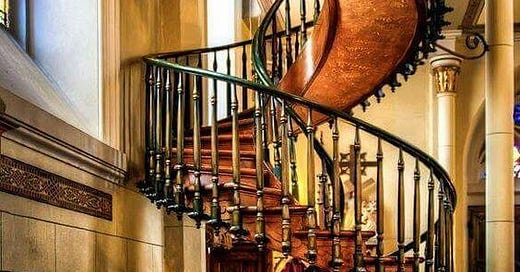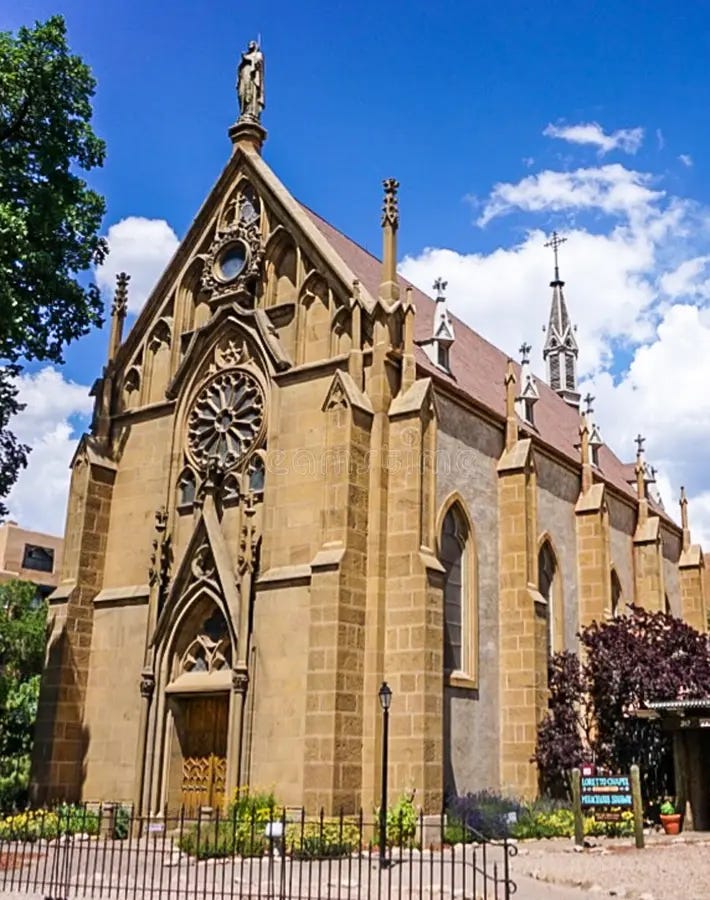NOTE: While this post is available to all, in order to give you a sample of the content to expect here on God Friended Me, in the coming days, most of the highly original content here will require a paid subscription, which supports my writing efforts.
As I strolled through the cobblestone streets of Old Town, New Mexico, the warmth of the sun on my face and the echoes of centuries-old history in my ears, I felt a deep connection to the past.
The adobe buildings, with their earthy hues and wooden vigas, seemed to whisper stories of faith, struggle, and miracles. Among these whispers, one story stood out—the story of the Miracle Staircase in Santa Fe.
I had longed to see it with my own eyes, to stand in the presence of what many believe to be a true miracle. But as fate would have it, my journey didn’t take me to Santa Fe that day. Instead, it left me with a yearning, a dream yet unfulfilled, and a story that continues to inspire my faith.
The Story of the Miracle Staircase
The tale of the Miracle Staircase begins in 1872, when the Sisters of Loretto arrived in Santa Fe to establish a school for young girls. These pioneering women, led by the devout Sister Madeleine, were determined to create a sanctuary of learning in the heart of the New Mexico Territory.
They commissioned a chapel to be built in the Gothic Revival style, a beautiful homage to their European heritage.
But as the chapel neared completion, a problem arose that threatened to derail their dream. The architect, who had designed the chapel, died unexpectedly before he could solve the problem of access to the choir loft.
The loft, perched 22 feet above the chapel floor, had no staircase leading to it. The sisters were left with a dilemma—how could they safely reach the loft without disrupting the chapel’s sacred space with a traditional staircase?
Desperate for a solution, the Sisters of Loretto turned to their faith. They prayed fervently to St. Joseph, the patron saint of carpenters, for divine intervention. Their prayers were filled with hope and trust, for they believed that God would provide them with a miracle.
And a miracle, it seemed, they received.
One day, as the story goes, a mysterious carpenter appeared at the chapel, offering to build the staircase. He arrived with nothing more than a simple toolbox and a humble demeanor.
The sisters, struck by his calm confidence, entrusted him with the task. For months, the carpenter worked in solitude, refusing any assistance or even payment for his work.
When the staircase was finally completed, the sisters were astounded. The structure was unlike anything they had ever seen—a spiral staircase that ascended gracefully to the choir loft, with two complete 360-degree turns and no visible means of support.
The staircase was constructed without nails, using only wooden pegs, and was made from a type of wood that experts say was not native to the region. There are 33 steps to represent the age of Jesus at the time of his death.
The carpenter disappeared without a trace, leaving behind no name, no bill, and no explanation. The sisters were left with only the staircase—a testament, they believed, to the power of prayer and the intervention of St. Joseph.
Apart from any claims of its miraculous nature, the staircase has been described as a remarkable feat of woodworking. According to a Washington Post column by Tim Carter:
"It's a magnificent work of art that humbles me as a master carpenter. To create a staircase like this using modern tools would be a feat. It's mind-boggling to think about constructing such a marvel with crude hand tools, no electricity and minimal resources."
My Dream to See the Staircase
As I wandered through Old Town that day, the story of the Miracle Staircase weighed heavily on my heart. I had wanted to visit the Loretto Chapel in Santa Fe, to climb those sacred steps, and to feel the presence of the divine in that holy place.
But time slipped away from me, as it often does, and I found myself heading back home without having made the pilgrimage.
Yet, the story of the Miracle Staircase has stayed with me, as vivid as the day I first heard it. I often dream of standing before that beautiful, spiraling structure, my hand resting on the smooth wood that defies explanation.
I imagine the quiet of the chapel, the sense of awe that must fill the space, and the whispers of the past that linger in the air.
Though I haven’t yet made it to the Loretto Chapel, I hold onto the belief that one day I will. Perhaps it will be when I least expect it, when the timing is just right, and God’s gentle nudge leads me there. Until then, the Miracle Staircase remains a symbol of faith for me—a reminder that miracles do happen, that prayers are heard, and that sometimes, the journey itself is as important as the destination.
A Journey of Faith Unfinished
Life is full of unfinished journeys, of dreams deferred but not forgotten. My desire to see the Miracle Staircase is one of those dreams, a journey of faith that is still unfolding.
And perhaps, in some small way, the staircase is already fulfilling its purpose in my life—not as a destination to be reached, but as a reminder to trust in the path that God has laid before me.
In the end, the Miracle Staircase is more than just a marvel of carpentry; it is a testament to the power of faith, the mystery of the divine, and the miracles that happen when we least expect them.
And so, I continue to dream, to pray, and to trust that one day, I will stand before that miraculous staircase, my heart filled with the same awe and gratitude that the Sisters of Loretto must have felt all those years ago.






